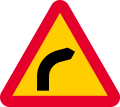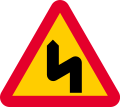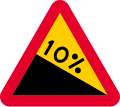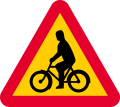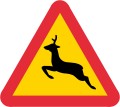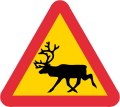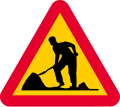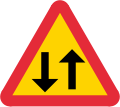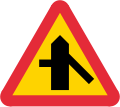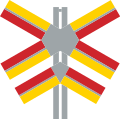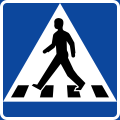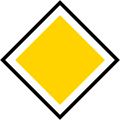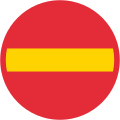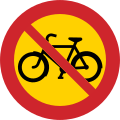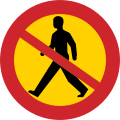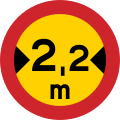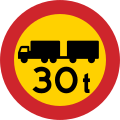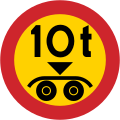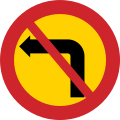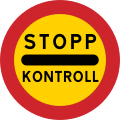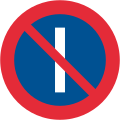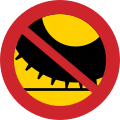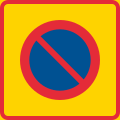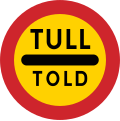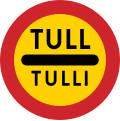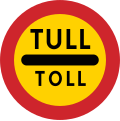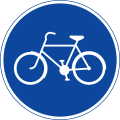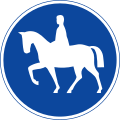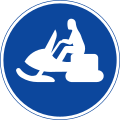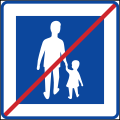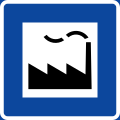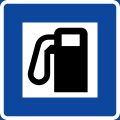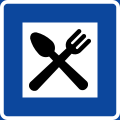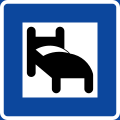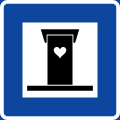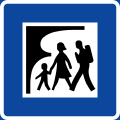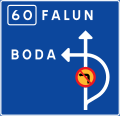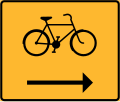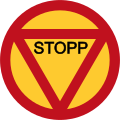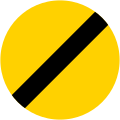Road signs in Sweden
This article needs additional citations for verification. (January 2016) |


Road signs in Sweden are regulated in the Traffic Sign Ordinance (2007:90) (VMF, Swedish: Vägmärkesförordningen).[1]
Most signs are based on pictograms, with some exceptions like the prohibition-sign for stop at customs and signal and speed limit signs. If the sign includes text, the text is written in Swedish, except the stop sign, which is written in English ("STOP").
Swedish road signs depict people with realistic (as opposed to stylized) silhouettes.
All signs have a reflective layer added on selected parts of the sign as is custom in European countries; most larger signs also have their own illumination.
The typeface used on Swedish road signs is Tratex.
Major differences between Swedish and general European signs
[edit]Like other countries in Europe, Swedish signs follow the Vienna Convention on Road Signs and Signals. Whereas European signs usually have white background on warning and prohibition signs, the Swedish signs have a yellow/orange colour. This is for the purpose of enhancing the visibility of the sign during the winter, as white signs would be hard to see in the snow. The prohibition signs have a red line across them if there is a symbol on them, not if it is a numeric value. General European prohibition signs do not usually have such a red line. Swedish warning and prohibition signs also have a thicker border than their European counterparts. Traffic signs in Iceland and Finland are quite similar.
History
[edit]Around 1930 some warning signs and prohibitory signs looking like today's signs with yellow background were introduced. The direction indication signs were however yellow with black text. Around 1965, there was a reform where the colour of those were changed to dark blue with white text. Around 1980, Sweden followed the Vienna convention rule that motorways should have a different colour, so green was introduced for them, and medium blue for ordinary roads.
Private road direction sign
[edit]This section's tone or style may not reflect the encyclopedic tone used on Wikipedia. (January 2025) |

The reason there is a sign indicating private road, is because they are not strictly private. A private road is a road that is not maintained by the state or municipality, but by a private person or association. An owner of a private road in Sweden can prohibit cars (but not people) from using the road. But if the state pays support for the maintenance, cars can't be prohibited. This is mostly the case if several families live along the road. Then they must form an association for it. The Swedish word for this kind of road is "enskild", that can be both translated to "private" and "individual". The background of the sign is yellow, indicating that the quality is often poorer, and warning signs might be missing. Signs indicating roads owned by companies or leading to companies usually have white background instead.
Warning signs
[edit]Warning signs are triangular in shape and have red borders, but in contrast with those of most other countries that use triangular warning signs, Swedish signs have yellow backgrounds, rather than white. More types of warning signs for animals are used than in most European countries, such as moose, deer, wild boar, reindeer, sheep, horse, and cow appearing alongside roads.
- Dangerous curve to left
- Dangerous curve to right
- Dangerous curves ahead, first to left
- Dangerous curves ahead, first to right
- Steep downhill
- Steep uphill
- Road narrows on both sides
- Road narrows on right sides
- Road narrows on left sides
- Unprotected quayside or riverbank
- Uneven road
- Speed refulcation bump
- Dip
- Slippery road
- Loose chipings
- Falling rocks (from) right
- Falling rocks (from) left
- Pedestrian crossing
- Pedestrian
- Children
- Cyclist and mopeds rides on carrigeway
- Skiers crossing
- Equestrian
- Moose
- Deer
- Cattle
- Wild horses
- Reindeer
- Sheep
- Wild boars
- Roadworks
- End of roadworks
- Traffic signals
- Low-flying aircraft
- Side winds
- Two-way traffic
- Tunnel
- Dangerous shoulder
- Crossroad intersection
- Crossroad without priority
- Right way at crooked intersection
- Right way junction from the left or right winding junction from right
- Right way junction from the left or right winding junction from left
- Side road priority on left
- Side road priority on right
- Skewed side road priority on left
- Skewed side road priority on right
- Roundabout
- Slow moving vehicles
- Horse drawn-carts
- Off-road-vehicles
- Traffic congestion
- Level crossing with barrier
- Level crossing without barrier
- Tramway
- Level crossing countdown
- Single track level crossing
- Multi track level crossing
- Other hazard
- Accident
Priority signs
[edit]The pedestrian and bicycle crossing signs are priority signs in Sweden, whereas the pedestrian crossing sign is regarded as a special regulation sign in the Vienna convention on road signs and signals. A sign for bicycle crossing is not yet implemented in the Vienna convention.
- Stop
- Pedestrian crossing (male person)
- Pedestrian crossing (female person)
- Priority road
- End of priority road
- Priority for oncoming vehicles
- Priority over oncoming vehicles
- Cyclists crossing
Prohibitory signs
[edit]Prohibitory signs are circular in shape with yellow backgrounds and red borders, except the international standard stop sign that is an octagon with red background and white border and the no parking and no standing signs that have a blue background instead of yellow.
- No entry
- Closed to all motor vehicles in both directions
- No motor vehicles
- No motor vehicles with more than two wheels
- No motorcycles
- No towed trailers
- No trucks
- No tractors
- No vehicles transporting dangerous goods
- No bicycles
- No mopeds
- No horse-drawn vehicles
- No snowmobiles
- No horses
- No pedestrians
- No vehicles exceeding width shown
- No vehicles exceeding height shown
- No vehicles exceeding length shown
- Minimum distance between motor vehicles
- No vehicles exceeding weight shown
- No vehicles or combination of vehicles exceeding weight shown
- No vehicles with a single axle weighing more than the weight shown
- No vehicles exceeding weight shown on a tandem axle
- No left turn
- No right turn
- No U-turns
- No overtaking
- No overtaking by trucks
- Speed limit
- End of overtaking prohibition
- End of overtaking prohibition by trucks
- Stop at the sign if the signal shows red
(only applies when driving towards the signal concerned) - Stop for police control. There are variants STOPP VAKT (stop for guard) STOPP FÄRJA (stop here when waiting for ferry)
- No parking or waiting
- No parking on odd days
- No parking on even days
- Date-based parking
- No stopping or standing
- No motor vehicles with studded tires
- Restriction zone.
In this example, this is no parking zone. However, the restriction doesn't apply when the signs inside the zone says otherwise. - End of the restriction zone
Stop at customs
[edit]The sign "Stop at customs" ("Stopp vid tull") is multilingual and exists in four variants.
- Danish
- Finnish
- German
- Norwegian
Mandatory signs
[edit]Mandatory signs are always circular in shape with blue signs with white border.
- Direction to be followed (turn left)
- Direction to be followed (turn right)
- Direction to be followed (go straight ahead)
- Pass on the right
- Pass on the left
- Pass either side
- Track for cyclists and mopeds
- Footpath
- Compulsory track for pedestrians, cyclists and moped drivers.
- Compulsory track for pedestrians, cyclists and moped drivers. Dual track
- Compulsory track for pedestrians, cyclists and moped drivers. Dual track
- Track for rider on horseback (and pedestrians)
- Track for off-road vehicles
- Beginning of lane reserved for public transport (and cycles and mopeds Class II).
- End of lane reserved for public transport (and cycles and mopeds Class II).
Special regulation signs
[edit]- Motorway
- End of motorway
- Expressway
- End of expressway
- Built-up area
- End of built-up area
- Pedestrian area
- End of pedestrian area
- Residential area
- End of residential area
- Low-speed road (recommended top speed)
- End of low-speed road
- Maximum recommended speed (in km/h)
- End of maximum recommended speed (in km/h)
- One-way traffic
- Dead end
- Passing place
- Parking (max 24 hours on weekdays except weekday before Sunday or holiday).
- Bus stop
- Taxi rank
- Toll road
Signs giving information
[edit]- Sign when entering Sweden from another country
- Post office
- Telephone
- Radio station for road and traffic information
- First aid
- Industrial zone
- Information
- Workshop area
- Petrol station
- Cafe
- Restaurant
- Hotel
- Hostel
- Holiday chalets
- Camping site
- Caravan site
- Rest site
- Toilet
- Bathing
- Open-air recreation
- Hiking trail
- Chair lift
- Tow lift
- Golf course
- Fishing licences on sale here
- National heritage
- Park and ride
- The long turn — mandatory turning manoeuvre for pedal cycles and mopeds.
- Advance direction sign, diagrammatic type
- Advance direction sign, stack type
- Lane preselection sign
- Lane merge
- Lane ends
- Temporary sign, left most lane ends
- Temporary sign, Lane merges with oncoming traffic
- Temporary sign, oncoming traffic merges with this lane
- Advance direction sign diagrammatic indicating prohibition of left turning
- Direction sign flag type
- Direction to motorway or expressway
- Sign to specific district or area
- Sign to place reached by a private road
- Sign to local amenities
- Lane assignment type
- Advance direction sign exit ahead from motorway or expressway
- Advance direction sign exit ahead from other road than motorway or expressway
- Direction sign exit sign
- Number of exit
- Lorries
- Car
- Airfield
- Airfield straight ahead
- Ferry
- Place indication sign
- Road number sign European highway
- Main highways (other than European highways) numbered 1–499
- Road number sign. Direction to a numbered road
- Road number sign for traffic diversion
- Confirmatory sign
- Grouped destinations (i.e. For Pajala and Övertorneå, follow signs for Kiruna)
- Recommended route for vehicles carrying dangerous goods
- Tourist route
- Tourist attraction area
- Landmark
- Sign to temporary event
- Recommended route for pedal cycles and mopeds
- Recommended route for pedestrians
- Disabled persons
- Stack type design
- Flag type sign
- Place indication sign
- Confirmatory sign
- Bike track
Other signs
[edit]- End of road works
- Limited access on side marker
- Limited access marker
- Limited access arrow marker
- Marking for sharp curves, bridge parapets, abutment, walls, tunnel mouths etc. Arrow marker
- Curve marker
- Exit
Additional panels
[edit]- High voltage cable
- Distance to
- Stop and give way at specified distance ahead
- Lateral clearance
- Total weight
- Times the restriction applies. Weekday; Weekday before Sunday or public holiday in brackets; Sunday and public holiday in red.
- Parking permitted for specified period between times shown
- No parking between times indicated
- Blind persons crossing or in the vicinity of the road
- Deaf persons crossing or in the vicinity of the road
- All way stop
- Parking configuration
- Parking configuration
- Parking configuration
- Parking configuration
- Parking garage
- Length of stretch of road beginning at specified distance from sign
- Length of stretch of road beginning at sign
- Prohibition effective in both directions of the sign
- Prohibition end at sign
- Prohibition effective in the direction of arrow
- Parking, effective in both directions of the sign
- Parking ends at sign
- Parking, effective in direction of arrow
- Symbol plate for specified vehicle or road user category (lorry)
- Symbol plate for specified vehicle or road user category (lorry)
- Symbol plate for specified vehicle or road user category (handicapped)
- Symbol plate for specified vehicle or road user category (car)
- Symbol plate for specified vehicle or road user category (car)
- Symbol plate for specified vehicle or road user category (bus)
- Symbol plate for specified vehicle or road user category (bus)
- Symbol plate for specified vehicle or road user category (motorbike)
- Symbol plate for specified vehicle or road user category (bike)
- Symbol plate for specified vehicle or road user category (caravan)
- Symbol plate for specified vehicle or road user category (caravan)
- Symbol plate for specified vehicle or road user category (car + caravan)
- Symbol plate for specified vehicle or road user category (car + caravan)
- Soft verges
- Forestry vehicle crossing ahead
- Direction sign
- Direction sign
- Direction sign
- Direction of priority road at intersection shape
- Two-way traffic on cycle and moped track
A Supreme Court case has clarified that if there are multiple individually framed additional panels for a road sign, they add information to the road sign, not to each other. The two panels in the case was Avgift (fee) and the other 4 hours 9–18, which means that there is mandatory fee anytime and maximum 4 hours 9 am-6 pm.[2]
Traffic light signals
[edit]Note: tip-down triangles indicates blinking/flashing light.
- Standard & arrow Red: Stop.
Red + yellow: The light is turning to green.
Green: Proceed.
Yellow: Stop, but only if safe to do so. - Flashing yellow: Traffic light malfunction or out of service.
- Cycles and moped lights.
- Pedestrian lights.
Red: Don't walk.
Green: Walk. - Public transport lights.
"S": Stop.
"S" + "–": The light is turning to "I" / arrow.
"I" (or arrow): Proceed (for indicated direction).
"–": Stop, but only if safe to do so. - Lane-control signals.
Red cross: Lane closed.
Yellow arrow(s): Lane closed ahead, change to indicated lane(s).
Green arrow: Lane open. - Lights at level crossing.
Flashing reds: Stop.
Flashing white (optional): Signals are operational. - Light signals at opening or swing bridges, ferries, airfields, emergency service stations etc.
Flashing reds: Stop. - Flashing yellow(s), accompanied with a sign: Drive with extra caution.
Road markings
[edit]- Centre line
- No overtaking line
- Warning line
- Centre line and no overtaking line
- Centre line and warning line
- Warning line and no overtaking line
- Double no overtaking line
- Reversible lane markings (lane that may be used for alternating direction of traffic flow)
- Guide line
- Reserved lane line
- Bike lane marking
- Broken edge line
- Continuous edge line
- Stop line
- Give way line
- Zebra crossing
- Bike crossing
- Lane selection arrows
- Deflecting arrow
- Obstruction marking; no crossing on or over that marking
- Text conforming bus and taxi lane, text conforming stop line
- Parking bay
- Standing and parking prohibited
- Parking prohibited
- Parking prohibited
- Bike and moped route
- Advance warning of obligation to give way
- Disabled persons
Signals by police officers
[edit]- Control
- Advance direction sign control
- 13.3.1 Slow down
13.3.2 Follow the police car and pull up behind it when it stops
13.3.3 Slow down
13.3.4 Drive off the road and stop in front of the police car
Obsolete signs
[edit]- Road works (1951–1967)
- Stop (1951–1975)
- Derestriction (1951–1980)
- Turn left (1937–1951)
- Turn right (1937–1951)
- Keep left (1937–1951)
- Built-up area, slow down (1937–1955)
- Residential area (1998–2007)
- End of residential area (1998–2007)
- Exit (1967–1980)
References
[edit]- ^ "Vägmärkesförordningen (2007:90)". Sveriges Riksdag. Retrieved 21 January 2025.
- ^ HÖGSTA DOMSTOLENS DOM meddelad i Stockholm den 18 augusti 2017 Mål nr T 3174-16 (in Swedish)


 French
French Deutsch
Deutsch
